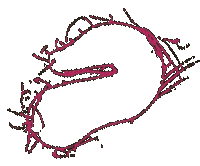February 26, 2004
work in progress
For one of the shows I have coming up in April, I think I might do my first performance piece. It's not so much a performance, as it's just taking the next step in the progression of complex instructions and situations that I create for participants interact with. I plan on becoming part of my work. I seem to be skipping the step of becoming an operator. As that, I would function as an initial facilitator in these situations and let the participants experience the work with no more input from me. I thought that might be a middle ground before becoming fully part of my piece. If I can get past the anxiety in my head, I will take the higher role of a coach.
In a large gallery, the group show will be held. The space is fairly open and most pieces will be wall based. As the crowd of people mingle and view the work, I will watch. I'm looking for somebody I'll feel comfortable with, someone who, on the surface, looks like they could go with the flow. Stranger, or acquaintance; it doesn't matter. Dressed in no special outfit, I will walk silently through the crowd. I approach my chosen participant and ask essentially "Excuse me. I was wondering if I might be able to show you something, teach you something for a minute?" In my hands, I hold a chair. This chair appears just as any ordinary chair. It lives up fully to its appearances. The only thing I require of my chair is that it be much like a typical kitchen chair, with the vertical supports of the back extending individually above where the horizontal element ends. I need that extra length of post or knob to do the action.
I wish to teach them a trick, a motion, something you can do with a chair. To get the action you have to tilt the chair up on to one of the front feet. You hold the chair from falling by placing your palm on the top knob that's on the opposite side (L,R) from the foot on the ground. You then have the chair in a very dynamic position. Your palm sits directly above the foot on the ground. Just by moving your hand in relation to the chair's center of balance, you can make the chair spin. It does not necessitate any twisting, rotation, or assistance from your other hand. When you get good, you can literally hold your palm completely flat and keep the chair under control just by the tilt of your hand. It's very important to be aware of how the weigh shifts to spin the chair. Higher rpm's come from practice.
To share this with people takes that level of participation that I'm not used to. The action dictates that I be there. Written instruction would not be universal enough for this complex situation. As I'm teaching this, I always watch. I observe the progress, what mistakes are being made, what goes well. The action is not hard to do. As they progress, I stay aware of my immediate surroundings. With my participant, I watch for that one moment, that one spark in their eyes that tells me that they got it. They feel the weight. They can spin it at unforced will , now. At that moment, with a snatch, I take my chair and run away.
The effect is to leave faster than they can process the sequence of events. There is no slow let down. This gives them a trigger, in their mind, for a snap shot of this moment and the previous experience. This will lead to future contemplation. This will lead to the participant wanting to go some degree beyond that level of learning by trying the spin at another time, in their own environment.
This motion may seem simple, like everyone can do it. Why do this particular action? There's nothing specific to that action, other than I respond to it intuitively. I've been spinning chairs longer than I've called myself an artist. It's a level of comfort coming from a deep study. I know this movement. I want to raise people's awareness and understanding of movement. I liken it to teaching art at basic levels. The goal of finger painting for first graders has nothing to do with doing it right or completely. Any exposure to the processes of art increases your visual vocabulary and ability. It helps to change what you see at the logical and intuitive level. You start to notice details, relationships, and feelings you haven't experienced before. This is what I want for my participants. I want to give them something that, while not life changing, adds to at least a small degree, to how they can appreciate movement. By studying how my prescribed actions take place and how they are interpreted in full play, I gather more knowledge that aids in my own appreciation of the minutia of the movements around me. Blah blah blah the world is a better place if you just look for it.


